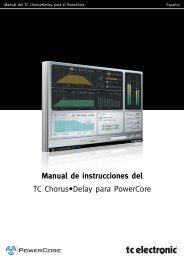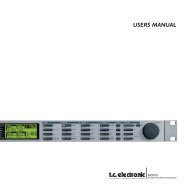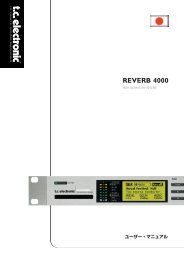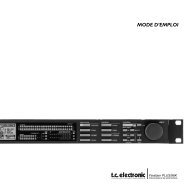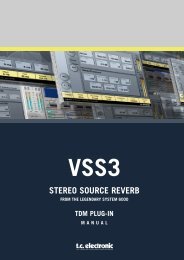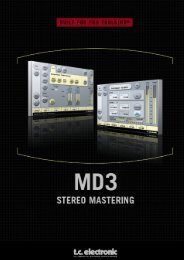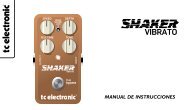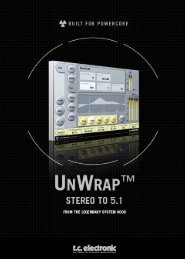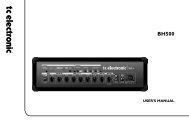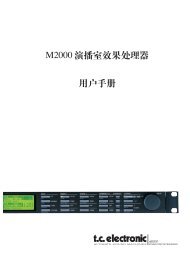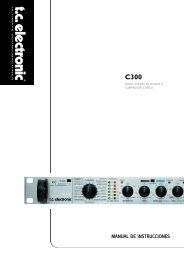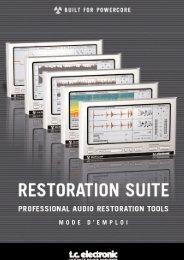EQ Station Manual v. 2.01 sw. 220 English - TC Electronic
EQ Station Manual v. 2.01 sw. 220 English - TC Electronic
EQ Station Manual v. 2.01 sw. 220 English - TC Electronic
You also want an ePaper? Increase the reach of your titles
YUMPU automatically turns print PDFs into web optimized ePapers that Google loves.
REAR PANEL<br />
<strong>EQ</strong> <strong>Station</strong> with<br />
fully expanded<br />
Analog I/O slots<br />
Analog I/O’s<br />
Depending on the configuration, up to 8 channels of analog<br />
I/O are available.<br />
More on <strong>EQ</strong> <strong>Station</strong>s Analog I/O<br />
<strong>EQ</strong> <strong>Station</strong> offers some of the finest converters available on<br />
any studio or live processor today. The wide dynamic range<br />
of these converters is complemented by analog domain<br />
gain scaling, so the full resolution of the converters can be<br />
used regardless of the operation level of the surrounding<br />
equipment.<br />
Analog I/O scaling<br />
Max operating level can be set at positions from, 3 to<br />
30dBu, each with additional Full Scale Safety Margin as<br />
shown on illustration below.<br />
For more exotic level handling requirements, the analog<br />
Inputs may take in signals as hot as +30dBu, and both<br />
Inputs and Outputs can have max level set as low as<br />
+3dBu. Analog gain scaling is performed in steps of 3dB<br />
between these extremes, and of course under automated<br />
control.<br />
To obtain good results from any audio system, level<br />
structure and overload margin between machines has to be<br />
set carefully. In Example No 1 of illustration above, the<br />
Mixer, <strong>EQ</strong> and Amp have not been properly adjusted: The<br />
Amp is driven to overload way before the drive capacity of<br />
the Mixer and <strong>EQ</strong> is exhausted, and the resulting dynamic<br />
range is only 94dB.<br />
The same equipment performs much better if the<br />
sensitivities are set as illustrated in Example 2. Mixers are<br />
often locked at a certain optimum level, but <strong>EQ</strong> <strong>Station</strong> and<br />
the Amps should still be set consciously. Normally, allow<br />
upstream devices to have a bit of headroom over later<br />
elements. The Safety Margin built into <strong>EQ</strong> <strong>Station</strong> ensures<br />
that the Amp will always get a clean feed, and eventually<br />
be the first to overload.<br />
Note that insert points even on hi-end consoles tend to<br />
operate at a lower max level than the mixer's main outputs.<br />
Typical balanced insert I/O scaling for <strong>EQ</strong> <strong>Station</strong> would be:<br />
- for unbalanced signals : 21dBu<br />
- for balanced signals : 24dBu<br />
10




